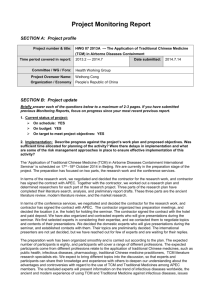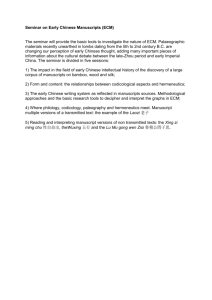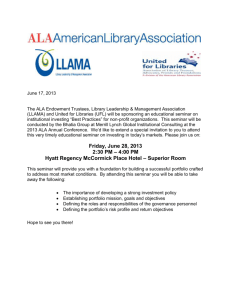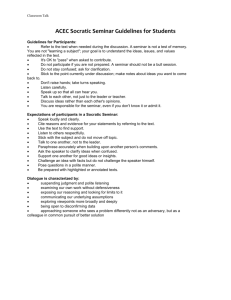HWG 07 13A CR
advertisement
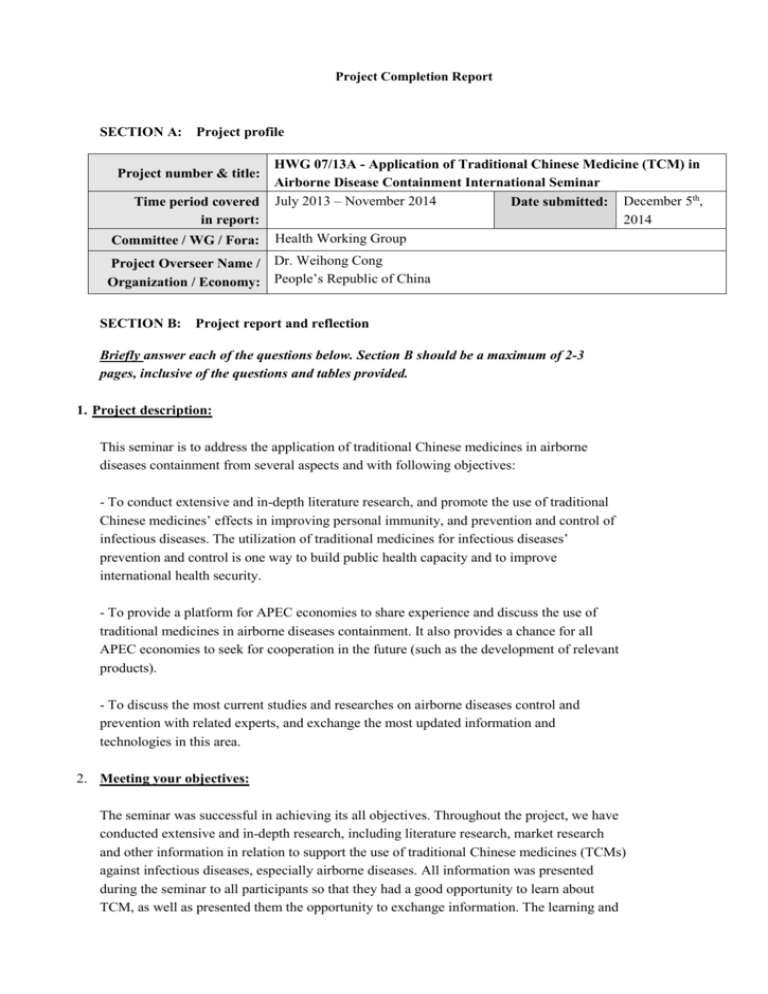
Project Completion Report SECTION A: Project profile Project number & title: Time period covered in report: Committee / WG / Fora: HWG 07/13A - Application of Traditional Chinese Medicine (TCM) in Airborne Disease Containment International Seminar July 2013 – November 2014 Date submitted: December 5th, 2014 Health Working Group Project Overseer Name / Dr. Weihong Cong Organization / Economy: People’s Republic of China SECTION B: Project report and reflection Briefly answer each of the questions below. Section B should be a maximum of 2-3 pages, inclusive of the questions and tables provided. 1. Project description: This seminar is to address the application of traditional Chinese medicines in airborne diseases containment from several aspects and with following objectives: - To conduct extensive and in-depth literature research, and promote the use of traditional Chinese medicines’ effects in improving personal immunity, and prevention and control of infectious diseases. The utilization of traditional medicines for infectious diseases’ prevention and control is one way to build public health capacity and to improve international health security. - To provide a platform for APEC economies to share experience and discuss the use of traditional medicines in airborne diseases containment. It also provides a chance for all APEC economies to seek for cooperation in the future (such as the development of relevant products). - To discuss the most current studies and researches on airborne diseases control and prevention with related experts, and exchange the most updated information and technologies in this area. 2. Meeting your objectives: The seminar was successful in achieving its all objectives. Throughout the project, we have conducted extensive and in-depth research, including literature research, market research and other information in relation to support the use of traditional Chinese medicines (TCMs) against infectious diseases, especially airborne diseases. All information was presented during the seminar to all participants so that they had a good opportunity to learn about TCM, as well as presented them the opportunity to exchange information. The learning and exchanging information process enable all participants to integrate TCM into their public health capacity building plans in the future and therefore to improve public health security among all APEC economies. Other than that, information presented by other participating economies helped us enlighten new ideas in terms of building public health response against infectious diseases. 3. Evaluation: To evaluate the success of the seminar, we sent out an evaluation sheet to all participants and speakers upon completion of the seminar (the evaluation form is attached).The evaluation form is divided into two parts: 1) meeting management and activities; 2) benefits from this seminar, as well as suggestions to organizers and PO. We received 13 evaluation forms from main speakers and active participants. The average score (to measure the success of the seminar) is 85.3 (out of 100). Most of the attendees were satisfied with the management of the seminar. Most of them indicated that through this seminar they knew more about the current situation and application of TCM in airborne diseases containment, which was helpful in terms of providing new elements for them to incorporate into public health capacity building in the future. The downside about the seminar pointed out by our participants was the simultaneous translation during the seminar. The quality of the translation could be improved better in the future. Overall, we were pleased with the results as we successfully got all information across all participants as planned, and we appreciate APEC Secretariat and their staff for their help and guidance through the preparation stage. 4. Key findings: All speakers and participants shared their research findings or experience in relation to infectious diseases containment during the seminar, including but not limited to: 1) there are strong literatures and researches to support the use of traditional Chinese medicine against airborne diseases. These formed a strong evidence base to promote the use of TCM among different APEC economies in the future; 2) there are gaps for promoting the use of TCMs due to regional laws, regional regulations, and different interpretations of TCMs and level of evidence that different economies appreciate; 3) there are market gaps for growing TCM based products against airborne diseases, which implied potential research directions, products trade, economic growth and job creation. Participants also indicated that this seminar had provided a great platform for them to exchange information not only in relation to TCMs, but also about airborne diseases, policies, networking and potential cooperative opportunities. 5. Next steps: Describe any follow-up steps or projects that are planned following the completion of the activity such as post-activity evaluations or tracer studies planned to assess the impact of this activity. Have the results of the activity been disseminated to participants and other stakeholders and how? What are (if any) any flow-on effects from this activity? How will this activity inform any future APEC activities? - - Evaluation: After the seminar, evaluation was conducted to measure the success of the seminar, as well as finding gaps for future improvements. Sharing information: All information was summarized to be ready presented to other APEC economies that did not attend the seminar through APEC Secretariat. To promote the use of TCMs, the success of holding the seminar and its potential influences have been published on some main media (news, website, newspapers that matters to the TCM field). Future research: The information and experience shared during the seminar could also direct our research in incorporating TCMs into other infectious diseases containment, such as Ebola. 6. Feedback for the Secretariat: Do you have any suggestions for more effective management of projects in the future? Any assessment of consultants, experts or participants that you would like to share? (The Secretariat collates and examines feedback to identify trends for ongoing evaluation of our project management and/or communications systems.) We would like to thank the APEC Secretariat, in particular Mr. Steve Chen and Mary Tan for their kind help and guidance throughout this project. 7. Participant information: Please provide details, where applicable. Insert rows as needed. e-mail Economy Title name Designation Organization address Participants Thailand Mr Tawat Buranatawons om Thailand Mr Wattana Panmoung Director Malaysia Ms Goh Cheng Soon Director Indonesia Mr Sumanto,SK M, MPHL Deputy Director Ms Rini Yudhi Pratiwi Toeloes Deputy Director Indonesia Director Viet Nam Ms Thi Ngoc Linh official Trinh Viet Nam Mr Tran Tung Dang speakers Director Institute of Thai-Chinese Medicine ,Department for Development of Thai Traditional and Alternative Medicine Thai Traditional and Integrated Medicine Hospital,Department for Development of Thai Traditional and Alternative Medicine,Ministry of Public Health Traditional and Complementary Medicine Ministry of Health Malaysia Filtration and Partnership, Directorate of Traditional Alternative and Complementary Health Services Traditional Health Management incharge of cooperation in APEC, Department of Int’l Cooperation, Ministry of Health Traditional Medicine Administration. Ministry of Health tawat_us@ya hoo.com dr-watt@hot mail.com dr.goh_cs@ moh.gov.my m_mantos@ yahoo.com rienhk@yaho o.com Trinhlinh198 4@gmail.co m Dttung120@ gmail.com Thailand Mr Sudhisak Pawaradhisa n Practitioner, Instructor Australia Mr Alan Bensoussan Professor Chinese Taipei Mr Lee Chun-Hsin professor Mr Chung-Jen Chen Mr Ziea Tat Chi Mr Liu Qing-quan Chinese Taipei Hong Kong,Chin a People's Republic of China Thailand Mr Sudhisak Pawaradhisa n The profession Chinese Medicine Committee of Thailand Board of Thailand Chinese Medicine Association Special instructor of Faculty of Chinese Medicine, Mah Fah Luang University National Institute of Complementary Medicine at the University of Western Sydney Taiwan Association of Intergrated Health Promotion mungkala@g mail.com A.Bensoussa n@uws.edu.a u lee.herb@ms a.hinet.net professor Kaohsiung Medical University Hospital 1030458@m s.kmuh.org.t w Chief (Chinese Medicine Department) Hospital Authority ztc766@ha.o rg.hk professor Beijing Hospital of TCM liuqingquan2 003@126.co m Practitioner, Instructor The profession Chinese Medicine Committee of Thailand Board of Thailand Chinese Medicine Association Special instructor of Faculty of Chinese Medicine, Mah Fah Luang University mungkala@g mail.com 8. Outputs: Please provide details, where applicable. Change headings or insert rows as needed. # planned # actual # of workshops / events √ √ √ √ # of CDs distributed √ √ # of websites created × × Other: × × # of publications distributed Details Seminar on the Application of Traditional Chinese Medicine (TCM) in Airborne Diseases Containment Oct 17-18,2014 Seminar guidebook Information packet for the seminar Scientific report(Ancient literature review, Modern literature review,market survey,related regulations survey) The information was distributed by flask disk which was given by organization on the seminar SECTION C: Budget Attach a detailed breakdown of the APEC- provided project budget, including: Planned costs (using most recently approved budget figures) Actual expenditures Variance notes: An explanation of any budget line under- or over-spent by 20% or more. SECTION D: Appendices or additions Please attach any of the following. This information will help us better understand your project, support overseers of similar projects and plan for future projects. List of experts or consultants utilized, with job titles and contact details, gender disaggregated where possible. List of participants, with job titles and contact details Event agendas Links to any relevant websites or online material (e.g. reports, resources created) Results of participant feedback or other project evaluation (raw and/or analyzed) Any other relevant information or resources that would help us learn more about your project FOR APEC SECRETARIAT USE ONLY APEC comments: Were APEC project guidelines followed? Could the project have been managed more effectively or easily by the PO?

